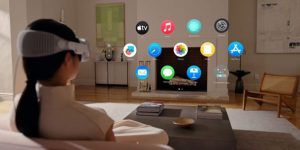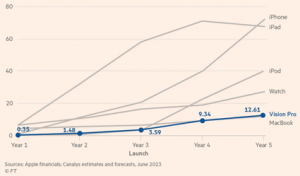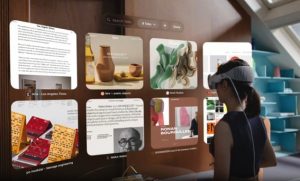Apple Vision Pro has been in development for over a decade. Now the wait is over.
This is what to expect from the Apple Vision Pro and the all new VisionOS.
Could you be tempted? Watch your favourite shows on a screen larger than your house, while sitting on a lunar landscape. Present your slide deck as if you were giving a TED talk, rather than Zooming it. Forgo your screen, laptop and keyboard, and use your hands and eyes instead to navigate, select and click. That, and much more, is the appeal of Apple’s “biggest release since the iPhone” (their words): the new Vision Pro headset.

But is the Vision Pro, Apple’s latest dip into Mixed Reality, about to usher in a new era of “spatial computing” (again, according to Apple) or will it join the ranks of other high-flying, but ultimately flawed ideas, from Google’s goggles to Meta’s own VR headset? And can it really change the way we work, communicate and interact with technology, in a world where the fight for talent and “back to the office” are gaining ground? Let’s see what the hype is all about.
Apple Vision Pro: the new “reality”
Mixed Reality (MR) is a technology somewhere between Virtual Reality (VR) and Augmented Reality (AR). While the term “VR” usually refers to a completely computer-generated environment, where the “real world” is blocked, “AR” is an environment where reality is augmented – or aided – by virtual elements such as graphics, sounds and audio, and tactile sensations. MR is essentially a blend between the real and virtual worlds, where elements of the physical and virtual world can interact. This is where you can find the new Apple Pro Vision.

By the way, Apple is not alone in its push for other realities: Microsoft HoloLens 2, HTC Vive Focus 3, and Meta’s Quest Pro headset, scheduled to for release the very same day, already make for a very competitive landscape. And it could just the start.
But what makes the Apple Vision Pro different from past attempts to convince users to join an alternative semi- digital universe? Apple certainly thinks so and estimates to surpass a 20 million user base in the first 5 years.

First, let’s talk specs: the Apple Vision Pro features two ultra-high-res micro-OLED displays that deliver a combined 23 million pixels – more than a 4K TV for each eye – with wide colour, high dynamic range, and Dolby Vision. It also features a new R1 chip, custom designed for the Apple Vision Pro headset, processes input from the cameras, sensors, and microphones for a lag-free, real-time experience.

The new MR headset will run on the new Apple operating system powered by the Apple M2 processor and a new operating system, VisionOS, which supports a wide range of apps, including games, educational apps, and productivity tools. VisionOs comes with its new, dedicated app store. Apple’s headset features precise head, hand, and eye tracking technology via more than 12 dedicated sensors. The list of tech specs goes and on and on, making this the cutting edge in MR headset technology. The question remains, what does it all mean for users – and how can brands tap into its possibilities?
Get to know 7 transformative use cases of AI for app development.
Applications and use cases
The big promise of Apple Vision Pro is to merge together the “real” and the virtual worlds together – one enhancing the other. It can be used for a variety of purposes, including entertainment (say watching your favourite shows while on a plane on a huge screen) or work (goodbye multiple screen, hello immersive work meetings).
Some potential use cases for companies with Apple Vision Pro are:
- Remote Training and Education: there’s a whole untapped potential for enhancing education with MR. We’re talking studying anatomy and physiology via AI-powered simulations, without the need to dissect cadavers, chemistry experiments in controlled environments, or even personalised learning experiences for students with special needs.
- Immersive Shopping and Enhanced Retail: virtual try-on experiences and interactive product demonstrations might as well not be a thing of the future. Combining the power of online and in-store shopping can make the whole experience more engaging and convenient.
- Healthcare and Therapy: from augmented reality-enhanced medical Imaging to therapy tools for patients with neurological conditions, healthcare will surely benefit from a myriad of innovative solutions.
- Travel and Exploration: overlaying virtual information on real-world environments is just one of many, many ways Apple Vision Pro could enhance a travel experience, along with real-time language assistance or even with extending accessibility to people with disabilities.
Does your business need AI or Machine Leaning?
MR tools such as the Apple Vision Pro can be used to create effective training experiences for employees to learn new skills, competences, and procedures in safe and realistic environments. At the same time, they can enable more efficient remote work by providing workers with a shared and collaborative virtual workspace where they can see and talk to each other, share files, and interact with virtual objects. Similarly, the customer experience can be enhanced with interactive product demos, virtual showrooms, or interactive, real-time customer service.
But other areas – such as field service and maintenance – can also benefit greatly from real-time technical guidance and instructions as workers interact with machinery and other equipment, or even product design and development departments, which can use MR to create realistic 3D models and prototypes and interact with them.
But the real opportunity here is for businesses who dare to be pioneers in the development of MR software and applications. Like almost always, the early adopters of MR technologies like Apple Vision Pro will probably not only shape its future but also reap the most significant rewards.
Limitations and challenges
Priced at a hefty US$3,499, the Apple Vision Pro headset is most definitely not an affordable, everyday solution yet for the majority of consumers. For businesses, the main challenge is the effort and cost associated with developing and deploying Apple Vision Pro-compatible solutions like VisionOS apps. Furthermore, there are still some questions about comfort, wearability, eye strain, potential side effects on health and wellbeing, accessibility, and others.
Preparing your business for Apple Vision Pro
If you are considering taking advantage of not only Apple Vision Pro but more widely MR tech, there are a few things you can do to prepare. As mentioned, Apple Vision Pro apps run on VisionOS, meaning any iOS app will most likely have to be adapted, and for other operative systems they may need to be totally adapted. Also, your teams will most likely need training on how to use Apple Vision Pro and on the specificities of the OS.





